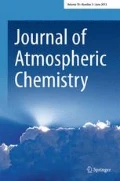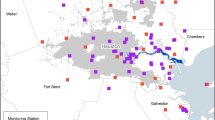Abstract
The paper presents a new receptor-based approach for investigating the effect of different mitigation strategies on surface ozone concentrations. The empirical approach relates measured ozone concentrations to 3-D back trajectories and European precursor emission data (NOx, VOC,isoprene). These are the only parameters used as input. Following a description of the method, results for two German stations, an urban and a rural mountain site, are described, and discussed in detail. For the urban site, precursor reductions of 50% in an area of 0.5 million km2 around thestation resulted in ozone reductions between 10 and 22% during a smog episode, and between 9 and 14% for the summer season. This compares well withCTM results. Increasing the area of reduced emissions above 0.5 millionkm2 does not lead to additional ozone reductions. Application of the procedure to the mountain site gives plausible results if only NOx, only VOCor only isoprene is reduced. However, simultaneous reduction of NOxand VOC leads to an unlikely ozone increase. Possible reasons for this are discussed, and proposals for testing and improving the method are made.
Similar content being viewed by others
References
Brasseur, G. P., Hauglustaine, D. A., Walters, F., Rasch, P. J., Müller, J.-F., Granier C., and Tie X. X., 1998: MOZART, a global chemical transport model for ozone and related chemical tracers, J. Geophys. Res. 103, 28265–28289.
Cardelino, C. A. and Chameides, W. L., 1995: An observation-based model for analysing ozone precursor relationships in the urban atmosphere, J. Air Waste Management Assoc. 45(3), 161–180.
Cooper, J. A., 1980: Receptor oriented method of air particulate source apportionment, J. Air Poll. Control Assoc. 30(10), 1116–1125.
Fay, B., Glaab, H., Jacobsen, I., and Schrodin, R., 1995: Evaluation of Eulerian and Lagrangian atmospheric transport models at the Deutscher Wetterdienst using ANATEX surface tracer data, Atmos. Environ. 18, 2485–2497.
Fricke, W., 1995: Ermittlung des Einflusses von NOx-Minderungen auf die Ozonkonzentration in ausgewählten Gebieten in Deutschland, Gutachten im Auftrag des Bayerischen Staatsministeriums für Landesentwicklung und Umweltfragen, Report available from the Bavarian State Ministry of State Development and Environmental Affairs, Rosenkavalierplatz 2, D-81925 München, Germany.
Fricke, W. and Vandersee W., 1999: Relationships between local ozone concentrations, regional precursor emissions and European atmospheric circulation patterns, in P. M. Borrell and P. Borrell (eds), Proceedings of EUROTRAC Symposium '98, WITpress, Southhampton.
Friedrich, R., Wickert, B., Blank, P., Emeis, S., Engewald, W., Hassel, D., Hoffmann, H., Michael, H., Obermeier, A., Schäfer, K., Schmitz, T., Sedlmaier, A., Stockhause, M., The-loke, J., and Weber, F.-J., 2002: Development of emission models and improvement of emission data for Germany, J. Atmos. Chem. 42, 179–206.
Fujita, E. M., Watson, J. G., Chow, J. C., and Zhiqiang Lu, 1994: Validation of the chemical mass balance receptor model applied to hydrocarbon source apportionment in the Southern California Air Quality Study, Environ. Sci. Technol. 28, 1633–1649.
Gilge, S., Kley, D., Volz-Thomas A., and Geiss, H., 1994: Messungen von Wasserstoffperoxid und organischen Hydroperoxiden am Schauinsland im Schwarzwald — Ein Beitrag zur Charakterisierung der limitierenden Faktoren bei der Ozonproduktion, Berichte des Forschungszentrums Jülich, Nr. Jül-2998, available from: Forschungszentrum Jülich, ICG2, Postfach 1913, D-52425 Jülich, Germany.
Gutsche, A. and Lefebvre, C., 1981: Statistik der ‘maximalen’ Mischungsschichthöhe nach Radiosondenmessungen an den aerologischen Stationen des Deutschen Wetterdienstes im Zeitraum 1957-1973, Berichte des Deutschen Wetterdienstes, Nr. 154, Offenbach am Main, p. 49.
Lin, C. and Milford, J. B., 1994: Decay-adjusted chemical mass balance receptor modeling for volatile organic compounds, Atmos. Environ. 28(20), 3261–3276.
Memmesheimer, M., Tippke, J., Ebel, A., Hass, H., Jakobs, H. J., and Laube, M., 1991: On the use of EMEP emission inventories for European scale air pollution modeling with the EURAD model, in Proceedings of the EMEP Workshop on Photooxidant Modelling for Long-Range Transport in Relation to Abatement Strategies, Berlin, 16–19 April 1991, pp. 307–324.
Neu, U., 1995: Ozonversuch Neckarsulm/Heilbronn, Band II, Wissenschaftliche Auswertungen, Report No. UM-6/II-95, available from: Umweltministerium Baden-Württemberg, Kernerplatz 9, D-70182 Stuttgart, Germany.
PROGNOS, 1995: Analyse der immissionsseitigen Effekte der Anwendung der Hessischen Ozonverordnung während der Ozonepisode des Sommers 1994, Final Report, available from: Hessisches Landesamt für Umwelt und Geologie, Rheingaustraße 186, D-65203 Wiesbaden, Germany.
Rahn, K. A., 1981: Relative importances of North America and Eurasia as sources of arctic aerosol, Atmos. Environ. 15(8), 1447–1455.
Seibert, P. and Jost, D. T., 1994: Investigation of potential source areas by statistical trajectory analysis of ALPTRAC aerosol measurements, EUROTRAC Newsletter 14, 14–17.
Simpson, D., 1994: Biogenic VOC emissions in Europe Part I: Emissions and uncertainties, EMEP/MSC-Wnote 5/94.
Stockwell, W. R., Middleton, P. Chang, J. S., and Tang, X., 1990: The second generation regional acid deposition model chemical mechanism for regional air quality modeling, J. Geophys. Res. 95, 16343–16367.
Stern, R., 1994: Entwicklung und Anwendung eines dreidimensionalen photochemischen Ausbreitungsmodellsmit verschiedenen chemischen Mechanismen, Meteorologische Abhandlungen des Instituts für Meteorologie der Freien Universität Berlin, Neue Folge, Serie A, Band 8, Heft 1, 584 S, Verlag von Dietrich Reimer, Berlin, ISSN 0342-4324.
Stohl, A., 1996: Trajectory statistics: A new method to establish source-receptor relationships of air pollutants and its application to the transport of particulate sulfate in Europe, Atmos. Environ. 30(4), 579–587.
UNECE, 1996: Manual on methodologies and criteria for mapping critical levels/loads and geographical areas where they are exceeded, UBA Texte 71/96, Umweltbundesamt, D-14193 Berlin, Germany.
Wickert, B., Schwarz, U., Blank, P., John, C., Kühlwein, J., Obermeier, A., and Friedrich, R., 1999: Generation of an emission data base for Europe 1994, in P. M. Borrell and P. Borrell (eds), Proceedings of EUROTRAC Symposium '98, WITpress, Southampton.
Author information
Authors and Affiliations
Rights and permissions
About this article
Cite this article
Fricke, W., Vandersee, W. & Gilge, S. An Empirical, Receptor-Based Procedure for Assessing the Effect of Different Ozone Mitigation Strategies. Journal of Atmospheric Chemistry 42, 5–22 (2002). https://doi.org/10.1023/A:1015773415326
Issue Date:
DOI: https://doi.org/10.1023/A:1015773415326



